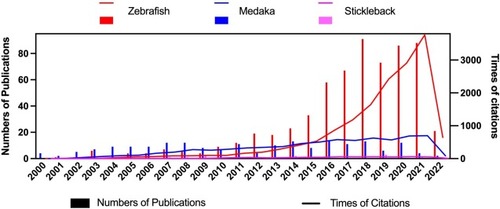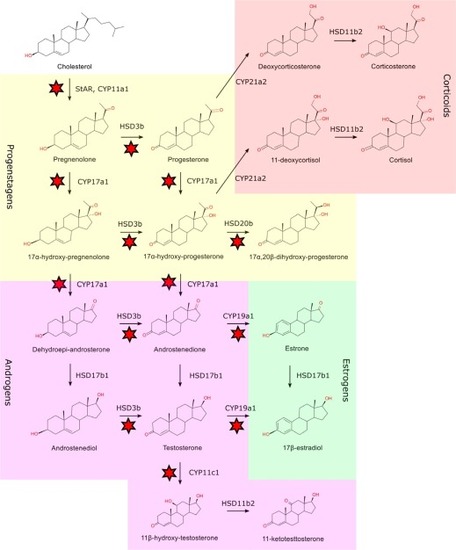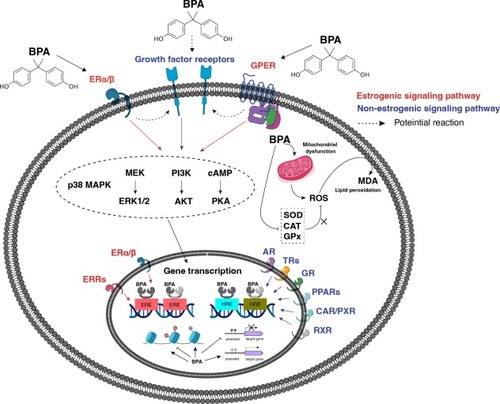- Title
-
Estrogenic and non-estrogenic effects of bisphenol A and its action mechanism in the zebrafish model: An overview of the past two decades of work
- Authors
- Yuan, M., Chen, S., Zeng, C., Fan, Y., Ge, W., Chen, W.
- Source
- Full text @ Environ. Int.
|
The numbers of publications and times of citations of Web of Science papers working on “zebrafish / medaka / stickleback bisphenol A” from 2000 to February 2022. The studies working on the zebrafish (red column or line) and BPA have steadily increased during past decades comparing with medaka (blue column or line) or stickleback (pink column or line). Column represents the number of papers published per year. Line represents the number of citations per year. Data is from the Citation report of Web of Science. (For interpretation of the references to colour in this figure legend, the reader is referred to the web version of this article.) |
|
Major steroidogenic pathways in zebrafish. Key enzymes are shown near the arrow heads at each step of the biosynthetic pathway. The hexagons near key enzymes indicate that BPA may affect steroid synthesis by affecting these enzymes. (StAR: steroidogenic acute regulatory protein; CYP11a1: cytochrome P450 family 11 subfamily A member 1; CYP11c1: cytochrome P450 family 11 subfamily C member 1; CYP17a1: cytochrome P450 family 17 subfamily A member 1; CYP19a1: cytochrome P450, family 19, subfamily A, polypeptide 1; CYP21a2: cytochrome P450 family 21 subfamily A member 2; HSD3b: hydroxy-delta-5-steroid dehydrogenase, 3 beta; HSD11b2: hydroxysteroid (11-beta) dehydrogenase 2; HSD17b1: hydroxysteroid (17-beta) dehydrogenase 1; HSD20b: hydroxysteroid (20-beta) dehydrogenase). |
|
Schematic diagram shows the estrogen-only (red line), non-estrogen-only (blue line), and both estrogenic and non-estrogenic signaling pathways of BPA (black line) that have been studied in the zebrafish. 1) The estrogenic activities of BPA showed that BPA can bind with ERα/β and GPER on the cellular membrane, in which co-acting with the growth factor receptors, and bind with ERα/β, GPER and ERRs on the nuclear membrane to induce their subsequent signaling pathways and regulate estrogenic BPA-target gene expression. 2) The non-estrogenic activities of BPA showed that BPA can bind with growth factor receptors on the cellular membrane, and bind with AR, TRs, GR, PPARs, CAR/PXR and RXR on the nuclear membrane to induce their subsequent signaling pathways and regulate non-estrogenic BPA-target gene expression. 3) In addition, BPA can go through both estrogenic and non-estrogenic signaling pathways to induce oxidative stress and epigenetic misregulation. (BPA: bisphenol A; ERα/β: estrogen receptor α/β; ERRs: estrogen related receptors; GPER: transmembrane G protein-coupled estrogen receptor; AR: androgen receptor; GR: glucocorticoid receptor; TRs: thyroid receptors; PPARs: peroxisome proliferator-activated receptors; RXR: retinoid X receptor; CAR: constitutive androstane receptor; PXR: pregnane X receptor; p38-MAPK: p38 - mitogen-activated protein kinases; MEK-ERK1/2: mitogen-activated protein kinase - extracellular signal-regulated kinase 1/2; PI3K-AKT: phosphatidylinositol 3‑kinase - protein kinase B; cAMP-PKA: cyclic adenosine monophosphate - protein kinase A; ROS: reactive oxygen species; MDA: malondialdehyde; SOD: superoxide dismutase; CAT: catalase; GPx: glutathione peroxidase; ERE: estrogen-responsive element; HRE: hormone-responsive element.). (For interpretation of the references to colour in this figure legend, the reader is referred to the web version of this article.) |



